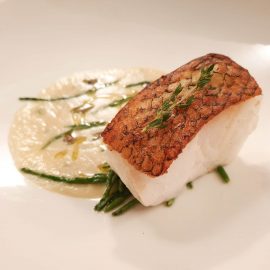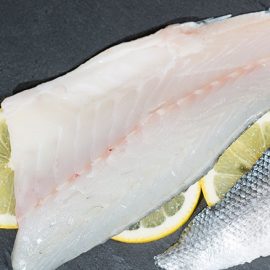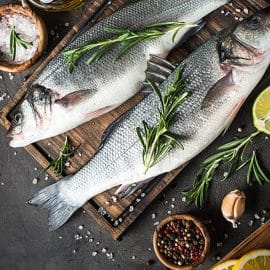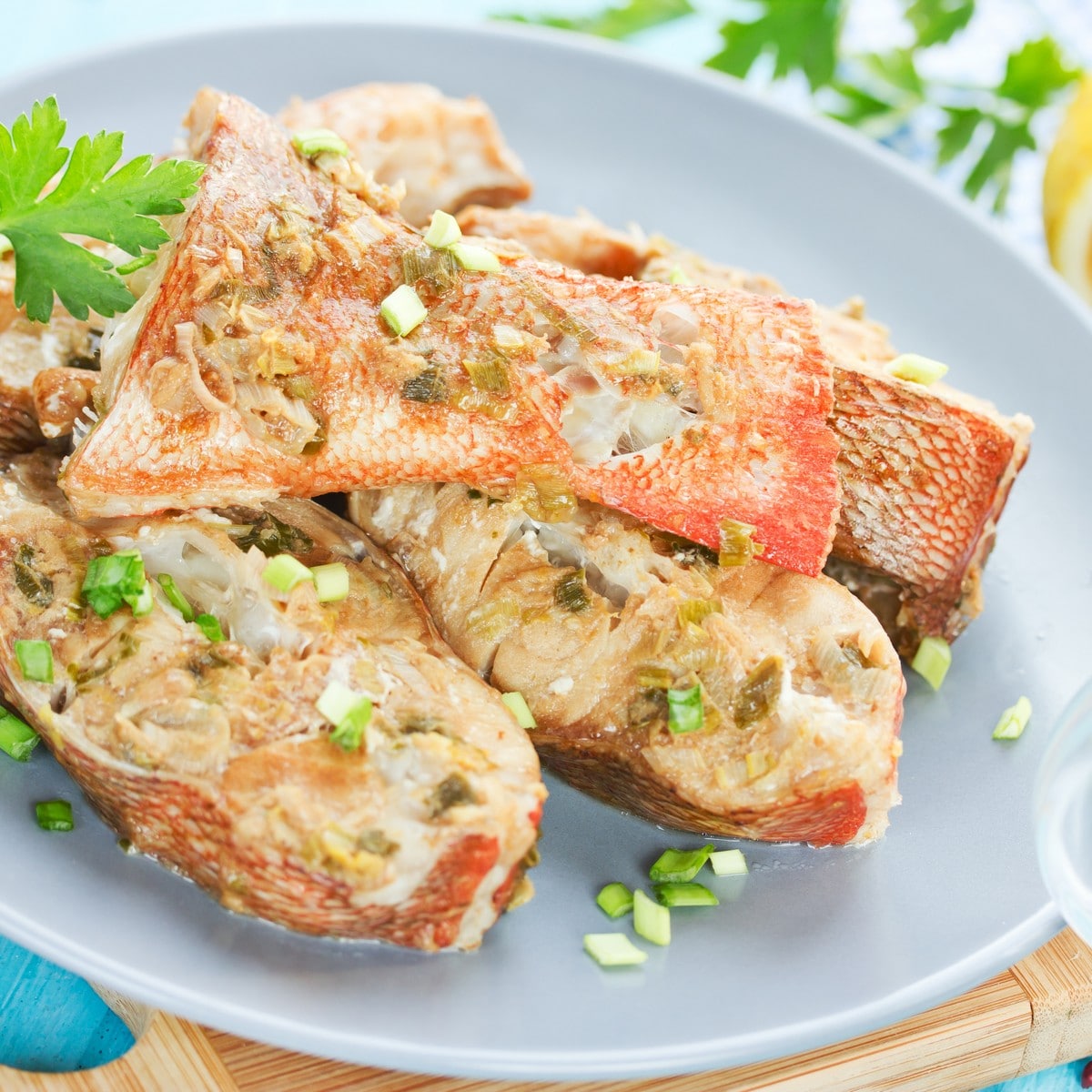
Introduction: Sea Bass – A Culinary Experience
Sea bass, also known as Branzino or Sparus Aurata, is a saltwater fish in many parts of the world and is widely regarded as one of the most popular and flavorful fish. It has a delicate white flesh and mild flavour, making it suitable for many recipes and cooking techniques. Depending on the cuisine, sea bass recipes can be found in many different cultures and prepared in restaurants or enjoyed at home.
Whether you are looking for a casual meal at home or an impressive dish to serve at a dinner party, sea bass is sure to satisfy you. By pairing it with suitable side dishes and sauces, you can elevate the meal to a new level of deliciousness.
Description
Sea bass (Family Serranidae) are marine and freshwater fish related to flounder, cod, and halibut. The delicate flavour of sea bass has made them popular with markets and recreational anglers worldwide.
They are fast and skilful predators, capable of making sudden changes in direction, and they feed on other small creatures such as fish and invertebrates. As a result, the sea bass plays an integral part in the marine environment, providing food for larger animals that dwell in the depths.
The different species of Sea Bass have varying flavour profiles, depending on where they swim and the food they eat. Black Sea Bass (Centropristis striata) is known for its sweet, delicate taste, while Chilean Sea Bass (Dissostichus eleginoides) has an oilier, buttery flavour.
Japanese Sea Bass (Lateolabrax japonicus) tends to have a mild and slightly fishy taste, with a hint of lemon. At the same time, Spotted Sea Bass (Cynoscion nebulosus) is sweeter but with a more robust flavour than other species.
Physical Characteristics
Sea bass is a type of finfish belonging to the family Perciformes, typically identified by its elongated, compressed body and large mouth, giving it a complete or spade-like shape. They also have two dorsal fins, one pectoral fin, a ventral fin near their gill plates, and an anal fin at the back of their body.
With various colours ranging from silvery-green to dark stripes or spots, sea bass may have sharp spines along their lateral line, distinguishing them from other fish species.
Depending on the species in question, sizes can range from a few inches to 1.2 metres (4 feet).
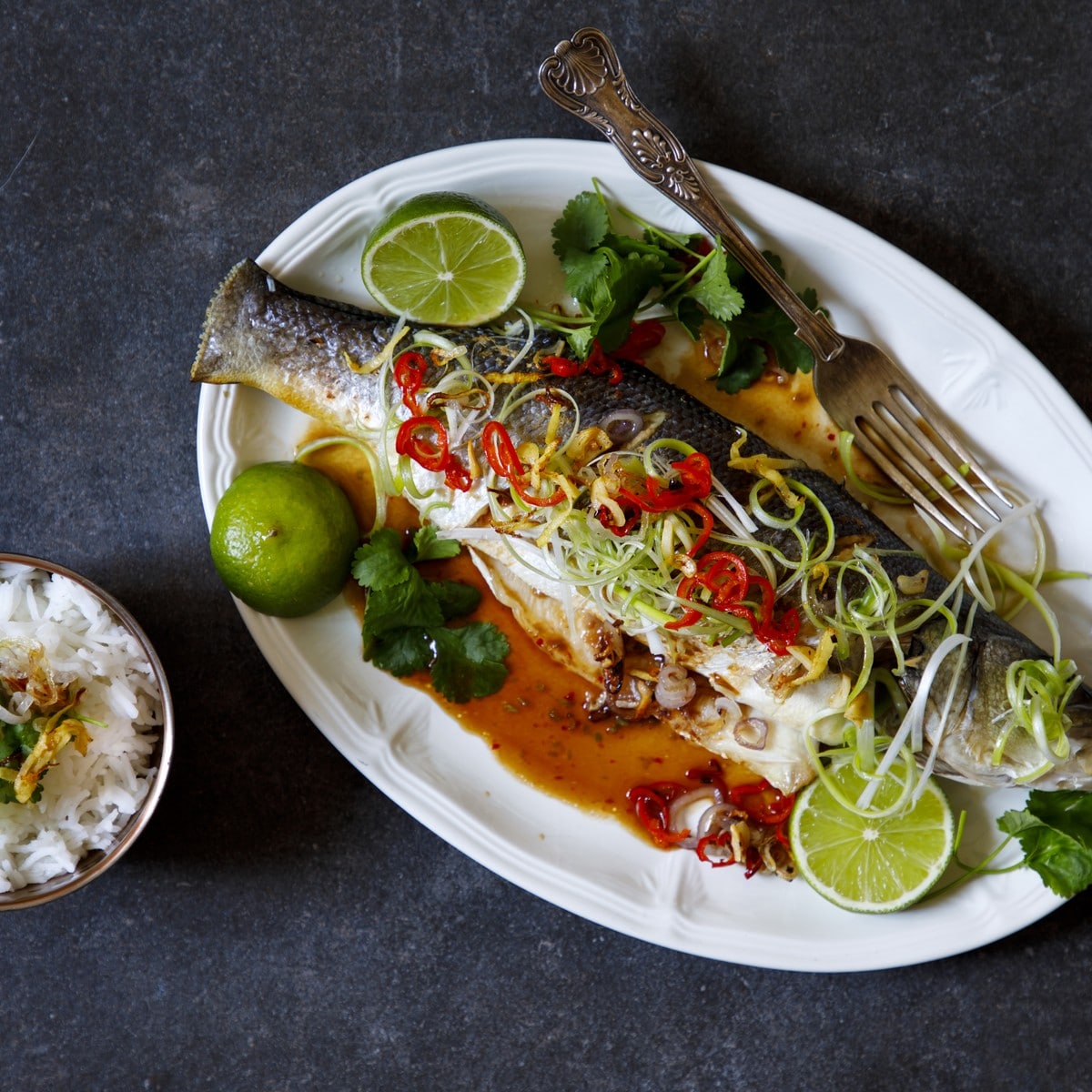
Movements & Habitats Of Sea Bass
Sea bass generally travels in large schools and migrate to the shallow, protected waters of the ocean during the day to forage for food. At night, sea bass stays in deeper parts of the warm and tropical seas. Depending on the food sources and environmental predators, sea bass may also migrate to different depths and more hospitable habitats. The growth rate of sea bass can be affected by factors like water temperature, availability of food, and predators in the environment.
Sea bass can be found in various habitats, preferring colder and shallower waters. However, some species can also live in deep, warm waters. They are typically bottom-dwellers and can be found along rock reefs, eelgrass beds, and soft mud bottoms.
Fishing Methods
Following fishery regulations, sea bass populations are sustainably caught using different fishing methods. These methods include trawling, mid-water trawling, purse seine, gillnetting, longlining and traps. Whole sea bass is usually sold to restaurants, sushi joints, and grocery stores, while the sea bass fillets are sold for commercial consumption.
Fisheries responsible for catching sea bass are heavily regulated and managed by both local and national governments to prevent overfishing and ensure sustainable populations.
Some species of sea bass are farmed in aquaculture fisheries alongside cod, halibut, and trout. Aquaculture has become an increasingly important tool for sustainably harvesting sea bass, and many governments have incentivised the development of this fishing method.
Population and Conservation
In recent years, the demand for sea bass has risen drastically, prompting a need for effective management and conservation of the species.
The International Council for the Exploration of the Sea (ICES) and other international agencies have established total allowable catches (TACs) with EU countries to help protect sea bass stocks and encourage sustainable fishing practices.
For example, the Fisheries Management Plan for the North Sea sets quotas for each member state, indicates where and when sea bass must be caught, and limits the use of particular fishing gear.
In the United States, the Endangered Species Act and the Magnuson-Stevens Fishery Conservation and Management Act prohibit any activity that harms sea bass.
Distribution of Stocks
The sea bass family of fish have a vast global distribution, inhabiting coastal waters worldwide. In North America, they are often referred to as Striped Bass, while in Europe, they may be referred to as White Sea Bass or Whitefish.
In South America, they are known as Corvina, in Australia as Snapper or Gummy Shark, and in Asia as Suzuki in Japan and Yang di or Black Fish in China.
Sustainable Fishing Practices
Certain regions may exercise total fishing quotas to prevent overfishing of sea bass and ban fishing during spawning seasons. Sustainable fishing methods, such as hook-and-line fishing, hand-lining, trolling and gillnetting, are encouraged to promote bycatch reduction by limiting the use of certain types of gear.
Bycatch reduction devices and other selective-fishing technologies, such as sea bass markers, minimise bycatch of juvenile fish and other species. Environmental organisations also promote a greater understanding and adoption of sustainable fishing policies and practices.
Sea Bass’ Diet & Hunting Techniques
With their dorsal, anal and pelvic fin spines, sea bass are carnivorous and consume a variety of small animals. The most common prey items include fish, squid, crustaceans, and other small sea life.
To capture prey, sea bass uses various hunting techniques, such as stalking and ambush. Sea bass can detect prey accurately with sensory organs on their head and mouth.
Spawning and Reproduction
Sea bass typically reaches sexual maturity between 2-4 years old during the spawning season (usually May through October). During this time, both males and females gather near reefs during the day and swim near shore at night. The females then lay 10–100,000 eggs that sink to the seafloor, where they develop into larvae.
Larvae remain in the open ocean for six weeks as they mature and reach the juvenile stage. Juvenile sea bass then starts to move back to the shallow waters and aggregations into schools. Depending on the species, adults usually stay together in the same schools or may begin to disperse.
Sea bass adults are also constantly on the move, migrating for different environmental conditions such as temperature and food availability. Once sea bass reaches full maturity, they are ready to reproduce again, starting the cycle anew.

Life Cycle of Sea Bass
Sea bass undergoes remarkable life stages essential for understanding their ecology and population size. Upon hatching, sea bass larvae stay in the ocean’s shallower layers and are vulnerable to predators and other threats to their survival.
Six weeks later, they become juveniles and inhabit their adult environment, typically at depths of up to 200 feet. Adult sea bass usually has a lifespan of three to five years, although some may live up to ten.
Classification
Sea bass is classified primarily according to their anatomy and behaviour, with most species belonging to the subfamily Serraninae. In addition to the distinctive line along their sides and tails, sea bass typically has big mouths, sharp teeth, and scales that range from smooth to covered in tiny spines.
Culinary Uses
Due to its moisture-rich meaty texture and delicious flavour, Sea Bass is one of the favourite seafood offerings of high-end restaurants worldwide. It can be easily prepared in various ways, such as grilling, baking, poaching, steaming, and stir-frying, and seafood lovers of all cultures enjoy it.
Significance
Sea bass is an important species to many marine ecosystems, being sought after globally for their flavorful meat and versatility in cooking. They are highly significant to the fishing industry and global commercial markets.
Uses
Sea bass can offer a range of health benefits and can be enjoyed at home or in restaurants. Various industries use sea bass, such as fish markets, recreational fishing, and sustainable fishing initiatives.
Due to the plentiful amounts of oil in their flesh, sea bass is highly sought-after as a food source. As such, they are sold as fillets, steaks, smoked or canned, making them an essential element of international cuisine.
Economic and Environmental Value
Due to the wide range of their diet and availability, sea bass has become a very popular fish in the commercial fishing industry, providing an essential source of food and export. As keystone species, they are of great economic and environmental value. Their health and population must be maintained for the survival of other species in their ecosystems and the fishing industry.
Sea bass is highly abundant in seawater worldwide, making it an important prey species for commercial fishers and recreational anglers. Sustainable practices and harvesting methods are often used in wild and marine farming to ensure the health of the fish populations. The fact that sea bass is both delicious and environmentally friendly contributes to the fish’s continued popularity.
Nutritional Values
Sea bass is nutritionally dense, providing several essential vitamins and minerals, such as Vitamin B12, phosphorous, selenium, zinc, and magnesium. They are exceptionally high in protein and omega-3 fatty acids, containing 0 grams of cholesterol and very low-fat levels.
Sea bass is higher in omega-3 fatty acids, protein, and vitamins than tilapia. Other similar fish include Grouper, Halibut, European Sea Bass, Chilean Sea Bass, and Asian Sea Bass. In comparison, these fish have identical qualities to sea bass but are typically more expensive.
Health Benefits
Due to its low-calorie content, sea bass can be an excellent food choice for those looking to maintain a healthy weight. Sea bass also contains omega-3 fatty acids, which benefit the heart. In addition, it is a good source of micronutrients such as iron, zinc, magnesium and potassium.
Sea bass is also rich in antioxidants, protecting the body from free radical damage and reducing inflammation. It is also a good calcium source, vital for bone health.
Taste and Texture
Sea bass has a mild, sweet flavour with a firm, buttery texture. They are often compared to white-fleshed fish such as cod, haddock, halibut, grouper, and other flatfish, as well as more fatty fish such as mackerel, tuna, salmon, sardines, and herring.
In terms of taste and nutrition, sea bass can be considered a milder-flavoured, high-quality alternative to cod and haddock, with a firmer texture for a healthy balanced diet. Sea bass is also compared to tilapia, with a similar mild flavour and texture.
Preparation
When preparing sea bass, tips such as scaling and gutting, par-boiling, cooking in parchment, steaming in a bamboo steamer or poaching in aromatic court bouillon should be considered. Sea bass’s flavoursome and versatile nature makes it suitable for various recipes.
The cheeks of sea bass are especially valued as a delicacy in some cultures and are usually steamed, baked fish, or sauteed in butter with spices.
The dorsal and anal fins of the fish are also edible but are not as widely used. They are traditionally used to make stocks or bouillon.
In South America, sea bass is often served as ceviche, a popular dish made of chopped raw fish marinated in lemon or lime juice, onion, chilli pepper, olive oil, and other seasonings. It is sometimes served as kabobs, involving chunks of fish and vegetables that are skewered on a metal or bamboo skewer and grilled at medium high heat.
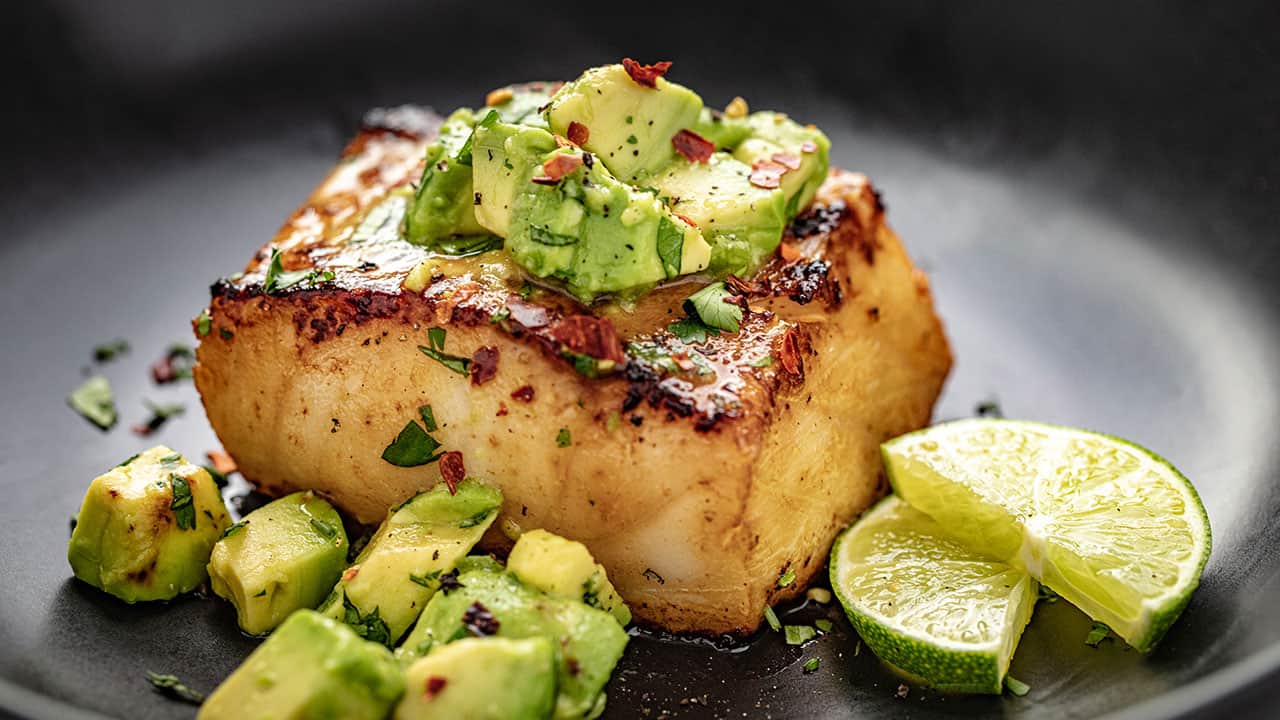
Side Dishes
Vegetable & Herb Side Dishes
Keeping the flavours light when pairing side dishes with sea bass is essential to let the fish’s delicate flavour shine through. Popular vegetables to serve alongside sea bass include carrots, broccoli, potatoes and green beans. Other vegetables such as squash, asparagus, tomatoes, spinach, and peppers can also work well when cooked with herbs and spices. Herbs and spices that can elevate the taste of sea bass include basil, oregano, rosemary, thyme, coriander, garlic and chilli peppers.
Potatoes, Rice & Grains
Potatoes are always an excellent choice for serving alongside sea bass. They can be mashed, roasted, boiled, scalloped or made into latkes for a crunchy addition to the meal. Rice and grains such as quinoa, couscous and bulgur also pair well with sea bass. Couscous, accompanied by lightly cooked vegetables and some lemon juice, offers a light yet flavorful side dish.
Salads, Fruits & Other Dishes
Other complementary dishes that pair well with sea bass include fresh salads, pickled onions, artichokes and different types of fish such as cod, salmon, mackerel and snapper. Sea bass also makes a great pairing with fruit-based side dishes such as oranges, strawberries, pears and apples.
Sauces, Condiments & Staples
No sea bass meal is complete without a delicious sauce or condiment. Sauces such as lemon butter, pesto and aioli, and horseradish cream provide an outstanding balance for the mild yet savoury flavour of the fish.
For an extraordinary touch, pair it with charred lemons, capers, garlic and herbs such as tarragon and dill. Finally, no sea bass feast would be complete without some staples such as crusty bread and olive oil.
Cooking Sea Bass
When preparing any sea bass dish, make sure the fish is completely thawed ahead of time. Whole fish should be gutted and cleaned before cooking, and then any bones should be removed from fillets.
Additionally, the oil should be heated to 375 degrees Fahrenheit when deep-frying. Lastly, ensuring that the fish is cooked and flakes easily with a fork is vital.
Popular Sea Bass Recipes
Popular recipes include Grilled or pan-fried, or baked sea bass, sea bass with garlic butter, crispy skinned sea bass, steamed sea bass fillet with soya sauce, miso-glazed sea bass and Asian-style sea bass.
Regional recipes include Mediterranean-style poached sea bass, Brazilian moqueca de peixe, Chinese-style steamed sea bass, British beer-battered fish and chips, Gremolata-crusted Sea Bass, Pesto-crusted Sea Bass, Miso-glazed Sea Bass, Lemon-butter Sea Bass, Sea Bass with Red Pepper Sauce, Chardonnay-poached Sea Bass, Sea Bass with Orange-Infused Olive Oil, Marinated Sea Bass, Sea Bass with Basil Sauce, Sea Bass with Sage Sauce, Tempura Sea Bass, Crispy Sea Bass, Sea Bass Green Curry, Coconut Sea Bass Soup, Grilled Sea Bass with Rosemary-Yogurt Sauce and Herb-crusted Sea Bass.
Traditions, History and Culture
Sea bass is associated with good luck and fortune in many cultures, and many religious festivals, recipes, and traditions are related to them. Throughout history, the trade of sea bass has also been an integral part of many societies.
Conclusion
The ever-popular sea bass continues to surprise and delight taste buds worldwide, thanks to its ancient origins and contemporary recipes. No matter the recipe or combination of flavours, the versatile and flavorful sea bass will make an impression. Whether served as a whole fish or in fillets, it is an excellent choice for those looking for a light, nutritious meal.

